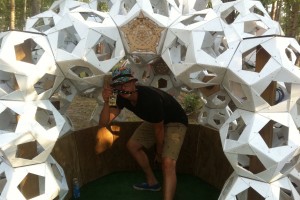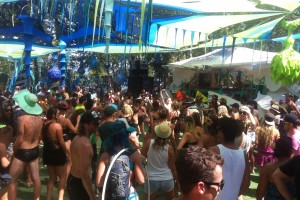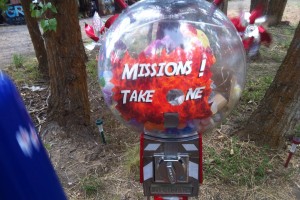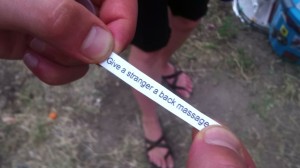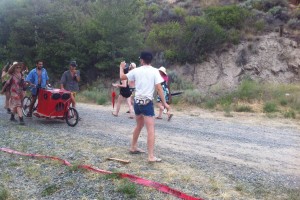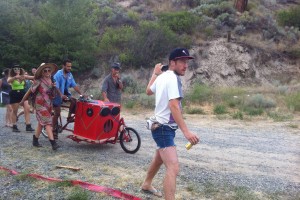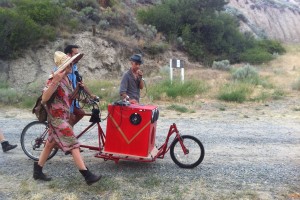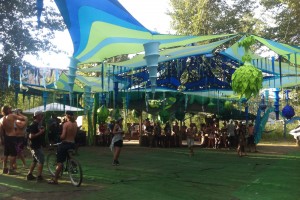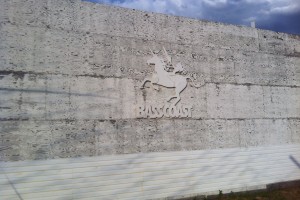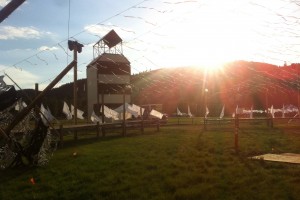When we initially applied to cover Basscoast the plan was to investigate the transformative effects of music festivals. This was partially inspired by The Bloom Series (i’d like to give a large ups to River, another media cat at Basscoast who has been involved with the production of this series) and from my own experiences at music festivals.
But, when inspiration hits, you have to roll with it. Once my colleague Paxcat and I arrived on the scene and began to discuss our plan, it became increasingly apparent that this festival was not primarily about transformations as individuals; I speculate that this is because a great majority of the festival goers were not first timers and their transformation happened long ago.
As several thousand individuals began to move into the desert of Nicola Valley in the south-central interior of BC, the transformation which we began to see was instead that of a group rather than that of the individual. My mind began to auto-formulate a survey with which to better understand the direction and reasons behind the collective change we were beginning to experience inside the festival grounds.
The survey I developed is as follows:
- How do you self-identify?
- Do you feel safe at this festival?
- Do you feel freedom at this festival?
- What is it that allows for this freedom?
- How can we bring this freedom back to regular society?
I asked these 5 questions (the last two being contingent on the third) to any person who happened across my path and seemed like a good choice to ask. In this way I was assured interesting responses from this ‘random’ sample of people. The questions produced responses which generally amazed me.
Among the identities I met were: a donair with wings, undecided/undecidable, a meatbag in a onesie, a skeptic/true believer, a star pirate of yesteryear, a coffee wizard, a teacher/empath, a spiritual warrior, a freak, a weirdo, a raver, normal, and a trekie.
In this (psudo)random survey I found no repeat answers for identity. How is it that thousands of people can congregate in one space with differing identities and, assumedly, different philosophies, world-views, religions, and/or values without a giant desert brawl breaking out? Any answer I give can only be speculation… that being said I am a gonzo journalist (rather than a pure anthropologist), and so I will speculate.
Based on experiences I have had in the past, it is likely that our individual identities and difference which allowed the festival to be an interesting and inspiring space; our difference did not serve to make us enemies but instead allowed us to be excited about the diverse experience we could access and interact with. And, it helps that generally, despite individual identities, everyone was unified by a few shared interests: electronic music, dancing, and having fun.
As for safety, there were a few people concerned about the sun’s ability to burn and one person explained an intense experience in the surrounding rural area while traveling to the festival grounds (all I can say is that sometimes farmers have guns). But, barring these issues, the general consensus was a definite feeling of safety. And, not once did I hear of a first hand experience of dangerous experiences inside the grounds. My best estimate for this feeling of safety comes from the onsite security, those volunteers in the sanctuary (a welcoming haven for anyone needing any sort of help, be that escape from the hot sun or escape from a bad trip), access to first aid services, the basic necessity of water being completely taken care of (thank you for water stations; it is a modern miracle that such an important substance is made safe and readily available; whenever I feel concerned about my ‘problems’ I will try to reflect on this to remind myself of how good I’ve really got it) and finally, and possibly most importantly, the distributed network of safety created by most/all of the festival goers–i.e. everyone was watching out for everyone else.
I am aware that freedom is a loaded word. If I was a fair anthropologist (instead of a gonzo journalist), I would have defined the term for the subjects I interviewed. Instead, I made an assumption: freedom is the ability for one to express themselves openly and act in any way they themselves choose, so long as those actions do not interfere with the freedoms of others. Although the wording of each persons response was slightly different–ranging from ‘without a doubt’ to ‘absolutely’–not one person of those surveyed deviated from an affirmative response. Whatever each person’s definition of freedom is, I have no doubt that their experiences at this festival were that of free individuals capable of, and even encouraged to, express themselves in the fullest.
How can it be that several thousand individual let loose in a valley could be capable of autonomy without their freedoms coming into conflict with that of others? Once again, those surveyed had a diverse set of responses, yet these answers were not so divergent as to be irreconcilable.
One individual told me that it is the collective imagination of the group which allows for such freedom. According to the subject, he could go up to anyone and say “Hi, I’m Bumbly the neapolitan wizard” and those he told would accept this as fact because festivals are group participation in the formation of our own cultural mythos. When one considers the diverse identities which permeated the survey, it is quite apparent that the residence of this festival had clear ideas of what they were (and, I assume, wanted to be), and because these realities do not interfere with my identity but instead informed and validated it, is clear that individual freedoms are not by necessity mutually exclusive but are instead mutually accordant; we are free as individuals only when we are together.
Another of those surveyed told me that the freedoms experienced were the result of mutual co-autonomy. As in, through respect and acceptance of each others autonomy we are free to be autonomous. Although different wording than ‘collective imagination’ it is not a stretch to see these as parallel, if not identical, concepts. Through acceptance of each other in a culture of non-judgment and respect, each person is given the space to embody themselves with full personal autonomy. As one basscoast citizen responded, the ability to be one’s true self.
It is important to recognize that this mutual co-autonomy does not exist out of enforcement. There was no-one going around making me, or anyone else, be free; that would be, by my earlier definition of freedom, impossible.
Given the space to be, and the opportunity to act without reproach from others as well as from the self, the collective, made up of free and autonomous individuals, is capable of existing without (much) written law–to be truthful there were a few rules to abide, which can be found here but at the end of the day the only thing any of the security personal cared about was safety–and without real conflict. Temporary autonomy appears to be available through collective (non)action and respect.
My own freedom from judgment went so far as to escape my own self-determined concerns over physical appearance; for three days I did not view myself in a mirror. This was not intentional, as I only realized it was the case on the second day when I awoke without undergoing the usual routine which takes place in my home’s bathroom. It is not that I could not find a mirror in the festival grounds (although, technically any item made of glass was banned) since there were many cars emblazoned with side and rear view metal backed crystallized sand particles. Instead, it simply had not occurred to me that I was in need of an examination of appearance and it was not until stopping for breakfast in Hope that I entered lavatory and looked up from the hand washing station to see the familiar image of myself. As I had expected from earlier on in the weekend, I looked well and there was no cause for alarm from the lack of self-viewing I had undergone. No one in the festival grounds would have minded if my appearance was sloppy and I believe the lack of need for a reflective examination may stem from the freedom from scrutiny emergent from such a righteous collection of humans.
As for bringing this freedom into the everyday world, many people I asked believed it was possible while some were convinced it could not be done. This question is, in the end, more of a tool to get people thinking about ways in which they could bring the Basscoast vibe back to the real world. Instead of feeding you, the reader, any of the answer which came across my tape-recorder, I challenge you to think about how you might bring about this mutual co-autonomy and respect to your self, your community, and the world.
In the end, Basscoast 2014 was a gathering of like-minded individuals hellbent on respecting one another’s autonomy and freedom. This was all without any authoritarian ruler, law, or law keepers but instead happened spontaneously through collective embodiment. The theme this year was Mutiny–a nice term to refer to pirates as the central mascot for the event–but I believe that one can look deeper at this term and see that in truth, nearly everyone who participated in the festival was a mutineer against oppressive forces in everyday life. Those forces which provoke us to feel like enemies rather than family. As I finish writing this I can feel a tear form as I think about the amazing collection of people I was lucky enough to experience; people I would be happy to call my family. To everyone I met, thank you for sharing your time and energy and thank you for being so goddamn real. I’ll see you next year at the reunion, i’ll be the one dressed as a cat wizard.
And, for those who did not make it this year and think it’s too good to be true; next year we better see you there.
Big Ups:
- Andrea Graham
- Liz Thomson
- Paul Brooks
- Robbie Slade
- Michael Red
- The Subdiv Krew
- Security (thanks for keeping us safe)
- First Aid (thanks for patching us up)
- The Sanctuary (thanks for letting us know it will be alright)
- The Green Team (thanks for picking up after us, we know that’s one thing we’ve gotta do better next year)
And, for those who have been paying attention, here is the
List of Unknown Useables:
- toilet paper
- socks (to put your water bottle in and tie to your belt)
- neti pot
- cotton swabs
